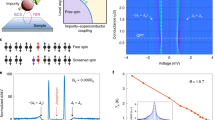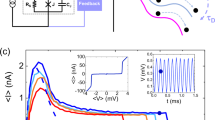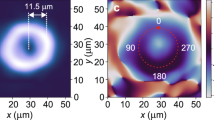Abstract
In a Josephson junction involving multiband superconductors, competition between interband and interjunction Josephson couplings gives rise to frustration and spatial disjunction of superfluid densities among superconducting condensates1,2,3,4,5,6,7. Such frustrated coupling manifests as the quantum interference of Josephson currents from different tunnelling channels and becomes tunable if channel transparency can be varied5,6,7,8. To explore these unconventional effects in the prototypical s±-wave superconductor FeSe (ref. 9), we use atomic-resolution scanned Josephson tunnelling microscopy10,11,12,13 for condensate-resolved imaging and junction tuning—capabilities unattainable in macroscopic Josephson devices with fixed characteristics. We quantitatively demonstrate frustrated Josephson tunnelling by examining two tunnelling inequalities. The relative transparency of two parallel tunnelling pathways is found tunable, revealing a tendency towards a 0–π transition with decreasing scanned Josephson tunnelling microscopy junction resistance. The simultaneous visualization of both superconducting condensates reveals anticorrelated superfluid modulations, highlighting the role of interband scattering. Our study establishes scanned Josephson tunnelling microscopy as a powerful tool enabling new research frontiers of multicondensate superconductivity.
This is a preview of subscription content, access via your institution
Access options
Access Nature and 54 other Nature Portfolio journals
Get Nature+, our best-value online-access subscription
$32.99 / 30 days
cancel any time
Subscribe to this journal
Receive 12 print issues and online access
$259.00 per year
only $21.58 per issue
Buy this article
- Purchase on SpringerLink
- Instant access to full article PDF
Prices may be subject to local taxes which are calculated during checkout




Similar content being viewed by others
Data availability
All data needed to evaluate the conclusions in the paper are present in the Letter and its Supplementary Information. Source data are provided with this paper.
References
Ota, Y., Machida, M., Koyama, T. & Matsumoto, H. Theory of heterotic superconductor-insulator-superconductor Josephson junctions between single- and multiple-gap superconductors. Phys. Rev. Lett. 102, 237003 (2009).
Koshelev, A. E. Phase diagram of Josephson junction between s and s± superconductors in the dirty limit. Phys. Rev. B 86, 214502 (2012).
Ota, Y. et al. Ambegaokar-Baratoff relations for Josephson critical current in heterojunctions with multigap superconductors. Phys. Rev. B 81, 214511 (2010).
Agterberg, D. F., Demler, E. & Janko, B. Josephson effects between multigap and single-gap superconductors. Phys. Rev. B 66, 214507 (2002).
Wang, D., Lu, H.-Y. & Wang, Q.-H. The finite temperature effect on Josephson junction between an s-wave superconductor and an s±-wave superconductor. Chinese Phys. Lett. 30, 077404 (2013).
Lin, S.-Z. Josephson effect between a two-band superconductor with s++ or s± pairing symmetry and a conventional s-wave superconductor. Phys. Rev. B 86, 014510 (2012).
Linder, J., Sperstad, I. B. & Sudbø, A. 0-π phase shifts in Josephson junctions as a signature for the s±-wave pairing state. Phys. Rev. B 80, 020503 (2009).
Stanev, V. G. & Koshelev, A. E. Anomalous proximity effects at the interface of s- and s±-superconductors. Phys. Rev. B 86, 174515 (2012).
Fernandes, R. M. et al. Iron pnictides and chalcogenides: a new paradigm for superconductivity. Nature 601, 35–44 (2022).
Randeria, M. T., Feldman, B. E., Drozdov, I. K. & Yazdani, A. Scanning Josephson spectroscopy on the atomic scale. Phys. Rev. B 93, 161115 (2016).
Hamidian, M. H. et al. Detection of a Cooper-pair density wave in Bi2Sr2CaCu2O8+x. Nature 532, 343–347 (2016).
Cho, D., Bastiaans, K. M., Chatzopoulos, D., Gu, G. D. & Allan, M. P. A strongly inhomogeneous superfluid in an iron-based superconductor. Nature 571, 541–545 (2019).
Liu, X., Chong, Y. X., Sharma, R. & Davis, J. C. S. Discovery of a Cooper-pair density wave state in a transition-metal dichalcogenide. Science 372, 1447–1452 (2021).
Stanev, V. & Tešanović, Z. Three-band superconductivity and the order parameter that breaks time-reversal symmetry. Phys. Rev. B 81, 134522 (2010).
Khodas, M. & Chubukov, A. V. Interpocket pairing and gap symmetry in Fe-based superconductors with only electron pockets. Phys. Rev. Lett. 108, 247003 (2012).
Kang, J., Chubukov, A. V. & Fernandes, R. M. Time-reversal symmetry-breaking nematic superconductivity in FeSe. Phys. Rev. B 98, 064508 (2018).
Moshchalkov, V. et al. Type-1.5 superconductivity. Phys. Rev. Lett. 102, 117001 (2009).
Babaev, E., Carlström, J. & Speight, M. Type-1.5 superconducting state from an intrinsic proximity effect in two-band superconductors. Phys. Rev. Lett. 105, 067003 (2010).
Vakaryuk, V., Stanev, V., Lee, W.-C. & Levchenko, A. Topological defect-phase soliton and the pairing symmetry of a two-band superconductor: role of the proximity effect. Phys. Rev. Lett. 109, 227003 (2012).
Iguchi, Y. et al. Superconducting vortices carrying a temperature-dependent fraction of the flux quantum. Science 380, 1244–1247 (2023).
Zheng, Y. et al. Direct observation of quantum vortex fractionalization in multiband superconductors. Preprint at https://arxiv.org/abs/2407.18610 (2024).
Chen, W.-Q., Ma, F., Lu, Z.-Y. & Zhang, F.-C. π junction to probe antiphase s-wave pairing in iron pnictide superconductors. Phys. Rev. Lett. 103, 207001 (2009).
Liu, X., Chong, Y. X., Sharma, R. & Davis, J. C. S. Atomic-scale visualization of electron fluid flow. Nat. Mater. 20, 1480–1484 (2021).
Deng, H. et al. Chiral kagome superconductivity modulations with residual Fermi arcs. Nature 632, 775–781 (2024).
Sprau, P. O. et al. Discovery of orbital-selective Cooper pairing in FeSe. Science 357, 75–80 (2017).
Ivanchenko, Y. M. & Zil’Berman, L. A. The Josephson effect in small tunnel contacts. Sov. Phys. JETP 28, 1272–1276 (1969).
Naaman, O., Teizer, W. & Dynes, R. C. Fluctuation dominated Josephson tunneling with a scanning tunneling microscope. Phys. Rev. Lett. 87, 097004 (2001).
Kimura, H., Barber, R. P. Jr., Ono, S., Ando, Y. & Dynes, R. C. Josephson scanning tunneling microscopy: a local and direct probe of the superconducting order parameter. Phys. Rev. B 80, 144506 (2009).
Uhl, M. et al. Multiband Josephson effect in an atomic scale Pb tunnel junction. Phys. Rev. Res. 6, 043233 (2024).
Carlstrom, J., Babaev, E. & Speight, M. Type-1.5 superconductivity in multiband systems: effects of interband couplings. Phys. Rev. B 83, 174509 (2011).
Grigorishin, K. V. Effective Ginzburg–Landau free energy functional for multi-band isotropic superconductors. Phys. Lett. A 380, 1781–1787 (2016).
Dong, X., Zhou, F. & Zhao, Z. Electronic and superconducting properties of some FeSe-based single crystals and films grown hydrothermally. Front. Phys. 8, 586182 (2020).
Acknowledgements
We thank D. Morr, B. Janko, M. Eskildsen and Y.-T. Hsu for valuable discussions. This work is supported by the US Department of Energy, Office of Science, Office of Basic Energy Sciences (DE-SC0025021 to X.L. for advanced SJTM measurements of unconventional superconductivity); the National Science Foundation, Division of Materials Research (DMR-2236528 to S.R.); startup funding from the University of Notre Dame and the Stavropoulos Center for Complex Quantum Matter (to X.L. for initially setting up the research laboratory); and the Notre Dame Materials Science and Engineering Fellowship (to N.S. and M.T.).
Author information
Authors and Affiliations
Contributions
X.L. conceived of the project. N.S. and M.T. performed the measurements. S.R. provided the FeSe crystals. N.S., M.T. and J.M. performed the data analysis. X.L. wrote the paper with input from all authors. All authors contributed to data interpretation.
Corresponding author
Ethics declarations
Competing interests
The authors declare no competing interests.
Peer review
Peer review information
Nature Materials thanks Jia-Xin Yin and the other, anonymous, reviewer(s) for their contribution to the peer review of this work.
Additional information
Publisher’s note Springer Nature remains neutral with regard to jurisdictional claims in published maps and institutional affiliations.
Supplementary information
Supplementary Information
Supplementary Notes 1–5, Figs. 1–12 and references.
Source data
Source Data Fig. 1
Data for plots and SJTM images in Fig. 1.
Source Data Fig. 2
Data for plots and SJTM images in Fig. 2.
Source Data Fig. 3
Data for plots and SJTM images in Fig. 3.
Source Data Fig. 4
Data for plots and SJTM images in Fig. 4.
Rights and permissions
Springer Nature or its licensor (e.g. a society or other partner) holds exclusive rights to this article under a publishing agreement with the author(s) or other rightsholder(s); author self-archiving of the accepted manuscript version of this article is solely governed by the terms of such publishing agreement and applicable law.
About this article
Cite this article
Sharma, N., Toole, M., McKenzie, J. et al. Atomic-scale frustrated Josephson coupling and multicondensate visualization in FeSe. Nat. Mater. (2025). https://doi.org/10.1038/s41563-025-02290-y
Received:
Accepted:
Published:
DOI: https://doi.org/10.1038/s41563-025-02290-y
This article is cited by
-
Frustration under the microscope
Nature Materials (2025)



